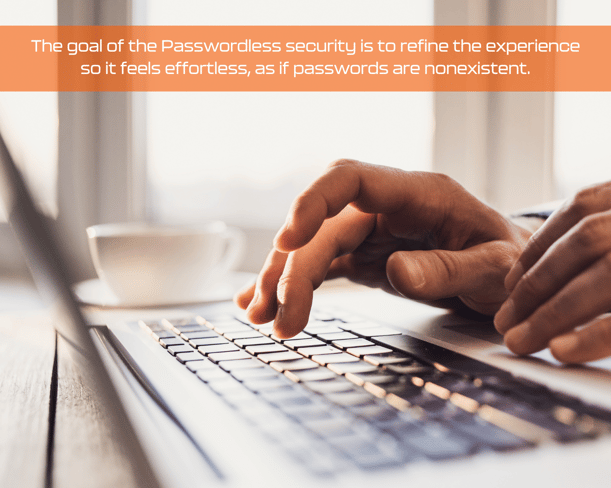Why User Experience Matters in Cybersecurity
At the heart of our digital era, identity security stands as a fortress, guarding the sanctity of both organizations and private citizens against the ceaseless onslaught of cyber threats. With the threat landscape swiftly morphing, the art of strengthening the security in our digital realms demands perpetual reinvention—not merely in the robustness of our defenses but in the finesse with which they intertwine with user experience (UX). It is within this intricate balance of strength and simplicity that the true power of identity security is unleashed, transforming what could be a cumbersome gauntlet into a seamless and intuitive shield that empowers users while steadfastly repelling and mitigating risk for organizations.
In this article:
The Paradox of Passwords and UX
Unlocking The High Costs and Risks of Poor Password Experiences
Engagement and Security: A Positive Feedback Loop
Immense Security Advantage Through Instant Password Re-Security
Bravura Pass Plus: Revolutionizing Security with a Passwordless Experience
Enhance User Experience and Security with Bravura Pass Plus – Explore the Difference
The Paradox of Passwords and UX
Passwords have been the cornerstone of online security for decades. However, they are not without their flaws. Users are frequently advised to create complex passwords, use different ones for each account, and change them regularly. This leads to what we call 'security fatigue' – a state where users become overwhelmed by the demands of maintaining secure practices, often resulting in poor security choices.
Compounding the problem, a bad user experience can push users to take shortcuts. Reusing passwords, writing them down, or choosing simple, easy-to-remember (and often easy-to-guess) passwords are just a few examples of the bad habits that can emerge when security measures are too cumbersome.
Unlocking The High Costs and Risks of Poor Password Experiences
Frequently, data breaches are less about sophisticated cyberattacks and more about human error and common password vulnerabilities. Weak, reused, or stolen passwords are a hacker's dream; they can be easily guessed, cracked, or phished. Disgruntled or malicious employees with access rights, or third-party vendors lacking robust security, can introduce significant risks. Breaches often occur through simple means like phishing, where staff reveal sensitive information inadvertently amid complex password management challenges. Accidental data exposure due to configuration errors, the theft of unencrypted devices, and social engineering tactics are also prevalent, alongside stealthy Advanced Persistent Threats (APTs) that aim for data theft or espionage.
The implications of a poor password user experience are critical, particularly in corporate and institutional settings where the stakes are high. Such an experience can be more than a nuisance; it can threaten the security of an entire organization. Here are the reasons why bad password UX is a serious concern:
1. Weak Passwords: Lax password policies can result in easily broken passwords, leading to security breaches.
2. Password Reuse: When users recycle passwords across different accounts, it allows hackers to breach multiple systems from one entry point.
3. Shadow IT: Overly complex passwords may drive employees towards unauthorized applications, inadvertently creating security risks and potential data breaches.
4. Phishing Threats: Complex password requirements can overwhelm users, making them more susceptible to phishing attacks and credential compromise.
5. Productivity Drain: Inefficient password systems waste valuable time and reduce focus, burdening IT support and hampering productivity.
6. Compliance Failures: Circumventing difficult passwords can lead to non-compliance with regulations like GDPR, resulting in substantial fines and damage to reputation.
7. Morale and Trust Decline: Continuous password issues can demoralize staff and undermine trust in IT systems, weakening the overall security culture.
8. Resource Misuse: IT departments overwhelmed by password-related issues may lack the bandwidth to address proactive security measures.
9. Reputational Harm: Security breaches due to poor password practices can damage a brand's reputation, affecting stakeholder trust and business relationships.
10. Intellectual Property Loss: Inadequate password security can lead to the theft of crucial trade secrets and proprietary data, undermining a company’s or institution's competitive edge.
Recognizing the severe outcomes of bad password UX, organizations must prioritize user-friendly security measures that bolster security while also fostering a more productive and compliant work environment.

Engagement and Security: A Positive Feedback Loop
The fusion of UX and cybersecurity presents a wealth of opportunities. By recognizing that an optimal user experience can enhance security practices, we can craft systems that not only safeguard users but also empower them. The objective lies in designing cybersecurity solutions that are robust yet intuitive. A notable trend in this domain is the shift toward passwordless experiences. The goal is not to abolish passwords entirely but to refine the security experience to such an extent that it feels effortless, almost as if passwords are nonexistent. This involves lessening our dependence on passwords by introducing alternative authentication methods like biometrics, one-time codes, or physical security keys, shaping the cybersecurity landscape where ease of use and protection coexist, fostering a safer, more user-friendly digital environment.
"Passwordless" authentication is designed to bolster security and streamline the user experience by obviating the need for password recall and entry. This method supplants traditional passwords with other verification means, employing a suite of technologies like vaulting and Multi-Factor Authentication (MFA) to guarantee secure access. Here's an overview of how these elements contribute to passwordless authentication:
Vaulting involves the secure storage and management of sensitive data, including passwords and credentials. In a passwordless framework, vaulting serves as a secure repository for user credentials, which the system retrieves and autofills as required. Strong encryption safeguards the vault, allowing users to forgo memorizing passwords and authenticate with the vault through alternative means.
Multi-Factor Authentication (MFA) is a security mechanism that mandates multiple verification factors to access a resource, whether it's an app, online account, or VPN. MFA transcends the "something you know" factor, such as passwords, by incorporating two or more of the following: something you have, something you are, and something you do. The amalgamation of these factors enhances security, significantly reducing the likelihood of unauthorized access even if a single factor is compromised.
Integrating vaulting and MFA in passwordless systems might look like this: users could unlock their vault with a biometric scan or a physical security key, and the system then automatically inputs the required credentials for service access. This process is unnoticeable to the user, freeing them from password memorization while still upholding robust security through layered verification.
Passwordless systems that combine vaulting and MFA simplify authentication, mitigate password-related risks such as theft or phishing, and vastly improve user experience by eliminating the burden of juggling complex passwords. This method doesn't just enhance security; it fosters compliance with security policies by aligning with natural user behavior and preferences.
Adopting passwordless authentication strategies, including passkeys and multi-factor authentication, can create a digital ecosystem that values security and ease of use in equal measure. This equilibrium is fundamental to contemporary cybersecurity initiatives and will play a pivotal role in the evolution of our digital security frameworks. A seamless user experience is vital to identity security and yields several advantages:
- Compliance: Intuitive, straightforward processes encourage adherence to security protocols.
- Reduction in Human Error: A smooth UX reduces the likelihood of user mistakes, a major source of security breaches.
- Higher Adoption Rates: Security features that are convenient are more likely to be accepted and used consistently by users.
- Trust: An effortless and professional UX can boost users' confidence in the security system, promoting further use of security features.
These methods promise a user experience without friction while maintaining or even boosting security levels. By embracing passwordless experiences, we pave the way for a digital realm that places a premium on both security and convenience. This delicate interplay is the hallmark of modern cybersecurity endeavors and will be critical to the success of our digital security infrastructure moving forward.
Immense Security Advantage Through Instant Password Re-Security
Users are often the unwitting landmines in the cybersecurity battlefield, with their password practices capable of triggering devastating breaches. Despite the best-laid security protocols, the human element remains the most unpredictable—creating complex passwords can lead to forgetfulness or resorting to unsafe storage methods, while password fatigue often results in the dangerous reuse of credentials across multiple platforms. Each user, with their individual habits and shortcuts, can inadvertently become a liability, as simple mistakes or lapses in judgment can open the door to cyberattacks. It is, therefore, crucial to recognize the role of user behavior in password security and deploy solutions like Bravura Pass Plus, which mitigate the risks by simplifying and strengthening password management, transforming potential vulnerabilities into bulwarks of an organization's digital defense.
In cases of accidental exposure or any other scenario requiring immediate password renewal without impeding productivity, being able to re-secure all passwords instantaneously would be invaluable for several reasons:
1. Immediate Response to Breaches: If an organization suspects a security breach or knows that credentials have been compromised, being able to reset all passwords immediately can help prevent unauthorized access. This swift action can stop attackers from exploiting stolen credentials, thereby limiting the damage.
2. Mitigating Continued Access: After an initial breach, attackers may continue to have access to systems. Immediate password re-securing would help to lock out these attackers and secure the system against further unauthorized activities.
3. Compliance and Trust: Organizations often need to comply with various regulatory requirements that mandate swift action in the event of a data breach. Being able to re-secure passwords across the organization can help in meeting these requirements and maintaining trust with customers and partners.
4. Operational Continuity: By quickly re-securing passwords, an organization can ensure that its operations continue with minimal disruption. This ability can be crucial for maintaining service availability and business continuity.
5. Reducing Administrative Overhead: Manually resetting passwords, especially in a large organization, can be time-consuming and prone to errors. An automated, on-the-spot process reduces the administrative burden and the potential for mistakes.
6. Risk Reduction: Quick password re-securing can reduce the window of opportunity for attackers to exploit compromised credentials, thereby minimizing the risk of data loss, financial impact, and reputational damage.
7. User Convenience: While changing passwords can be disruptive for users, a swift and clearly conveyed procedure can mitigate the disruption compared to a prolonged, uncertain one. This can also help in reassuring users that the organization is in control and taking decisive action to protect their data.

Bravura Pass Plus: Revolutionizing Security with a Passwordless Experience
Bravura Pass Plus seamlessly merges tight security with user-friendly access. It delivers a stress-free, passwordless experience while maintaining password-level security. Users enjoy simplified access and top-notch security, thanks to secure credential storage and password management aligned with organizational policies. The platform reduces password fatigue and elevates security with features like secure auto-fill and automated updates, creating a smooth, uninterrupted digital workspace.
In case of security breaches, Bravura Pass Plus enables quick credential recovery, minimizing downtime and safeguarding business operations. The centralized password management system instills confidence with its robust recovery capabilities.
The Password Risk Dashboard offers a transparent view of security risks, identifying weak passwords and providing actionable insights to enhance organizational compliance and password security.
Bravura Pass Plus strikes the perfect balance in cybersecurity. It eliminates password hassles, mitigates risks, improves compliance, and fosters user trust. Organizations benefit from rapid re-securing of credentials, ensuring ongoing operational resilience and protection against unauthorized access.
Enhance User Experience and Security with Bravura Pass Plus – Explore the Difference
Don't let the challenges of password management compromise your organization's security and user experience. Discover how Bravura Pass Plus can transform your approach to identity security. Click here to learn more about Bravura Pass Plus and take the first step towards a passwordless experience for your users and your organization.
Related Articles
How Ditching Your Passwords Can Help Increase Cyber Safety
You deal with dozens of passwords on a daily basis, both inside and outside the workplace. But with today’s increasingly complex cyberattacks, reliance on password...